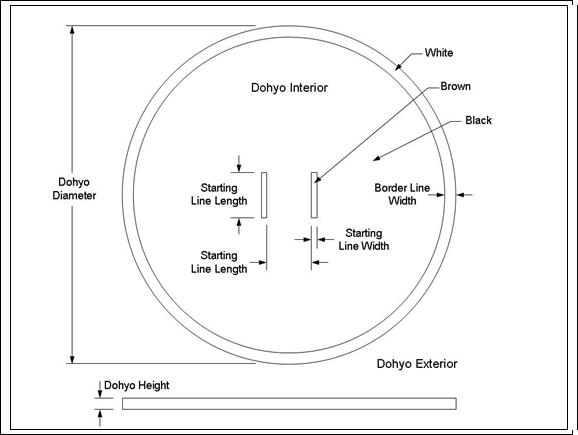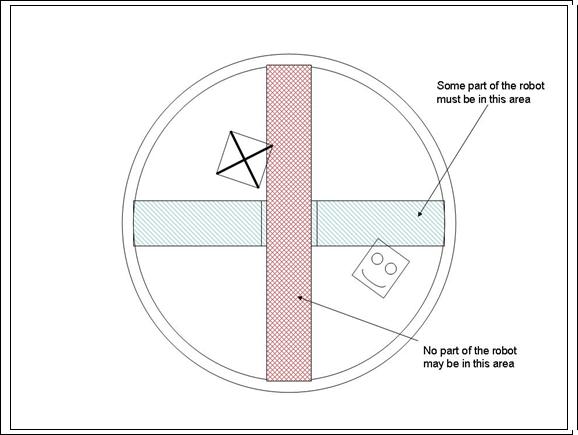Sumo Rules for CIRC Bot Boogaloo
Chapter 1: Robot Sumo
Article 1–Definition
A Sumo contest involves two contestants who operate robots in the sumo ring (Dohyo) according to the game rules presented here. The individual contest continues until two Yuko points are scored by one of the contestants.
Chapter 2: Dohyo Specifications
Article 2–Definition of the Dohyo Interior
The dohyo interior is defined as the dohyo area surrounded by and including the border line.
Article 3–Dohyo
A dohyo is a flat cylinder with the dimensions as shown in Table 1 and Figure 1. The dohyo can be made out of any material as long as geometrical specifications are maintained.
Table 1
| Class | Diameter, cm | Height, cm | Border Line Width, cm | Starting Line Width, cm | Starting Line Length, cm |
| 3kg | 154 | 5 | 5 | 2 | 20 |
| Mini | 77 | 2.5 | 2.5 | 1 | 10 |

Figure 1
- The top surface is to be flat and smooth with no dents, indentations, bumps, seams, creases, folds, edges, or any other defect that can interfere with the motion of the robot. The surface will be non-glossy black in color.
- The starting lines (Shikiri-sen) are two parallel brown (color ratio—blue : red : yellow = 4 : 4 : 2) lines with a width and length as defined in the table above. The inside edges of both starting lines are to be parallel, separated apart by the length of the starting line, and centered on the dohyo.
- The outer edge of the dohyo, the border line, is indicated as a white circular ring with a width as defined in the table above with an outside diameter equal to the diameter of the dohyo.
- During the games, it is up to the referee to decide whether the dohyo can continue to be used or whether it should be replaced.
Article 4–Dohyo Exterior
The exterior area of a dohyo extends at least 100 cm from the border line. The color of the exterior can be any color except white. There are no restrictions on the type of material that can be used or the shape of the exterior, as long as they do not violate the spirit of the rules.
Chapter 3: Robot Specifications
Article 5–Specifications
The robot must be able to fit inside a square box with the inside dimensions for the weight class as defined in Table 2.
Table 2
| Class | Length, cm | Width, cm | Height, cm | Maximum Weight |
| 3kg | 20 | 20 | Unlimited | 3.0 kg |
| Mini | 10 | 10 | Unlimited | 500 g |
- Weight (including accessories) must not exceed the maximum weight as defined in the table above.
- There are no restrictions on the type of control method used with autonomous robots.
- An autonomous robot should be designed to begin action no earlier than five seconds after the contestant presses the robot’s start button.
- There are no restrictions on the type of microprocessor or the amount of memory used in the robot (see exceptions below for the Lego class).
Article 6–Restrictions on Robot Design
The following restrictions shall apply to the robot design:
- The robot will not include a device that obstructs the control of the opponent’s operation, such as a jamming device or strobe light.
- The robot will not include any attachments or exhibit any behavior whose purpose is to damage the opponent.
- The robot will not present a hazard to event competitors, officials, or spectators. Any robot deemed by the judges to be hazardous will not be allowed to compete.
- The robot will not include any parts that might damage or deface the dohyo.
- The robot will not include a device that insufflates (pour, spill, drop, ooze, eject, fire, shoot, squirt, etc) any liquid, powder, or gas.
- The robot will not include an inflaming device.
- The robot will not include a throwing device.
- The robot will not include any part that fixes the robot to the dohyo surface and prevents it from moving (such as suckers, glue, and so on).
- The robot will not include any device that increases the apparent weight of the robot. Examples include: sticky wheels, using vacuum, fans, or magnetic systems to pull/push the robot down onto the dohyo surface.
Chapter 4: Game Principles
Article 7-Robot Divisions
- Mini sumo 500 g
- Mega sumo 3 kg
- A novice division of mini sumo 500 g may be offered at the discretion of contest organizers if sufficient interest is shown by competitors. The rules and operation of this division are identical to regular mini sumo, except for the following restriction on which robot builders are permitted to enter. If a robot builder has entered and placed in the top three in any autonomous sumo competition, then the builder shall not be eligible to enter the novice division, and must instead enter the regular mini sumo division.
Article 8–Game Principles
- A standard match consists of up to three bouts, each bout ending when one of the contestants wins a Yuko point.
- The first contestant to win two Yuko points is the winner of the match.
- The total duration of a match will not exceed three minutes of fighting time.
- When neither contestant receives any Yuko points, or both contestants have the same number of Yoko points, the winner will be decided by the judge. The judge will select the winner based on which robot was more aggressive. However, if no obvious superiority exists and a winner cannot be determined, one extra bout can be played to determine the winner, at the judge’s discretion.
Chapter 5: Match Procedure
Article 9–Beginning of the Bout
A t the judge’s direction, the contestants simultaneously put their robots on or behind their starting lines, with some part of the robot in the starting rectangle as illustrated in Figure 2. No part of the robot can be placed in front of the starting line before the bout begins.

Figure 2 . Robot “X” is in an illegal starting position because no part of it is in its starting rectangle, and it has a part in front of the starting line.
- At the referee’s signal, the contestant can press the start button on the robot. The bout begins five seconds after the referee’s signal. The contestant must exit the dohyo when the bout begins.
- Prior to the start of a bout, the entire robot must fit inside a square box as defined for the weight class. At any time after the start of the bout, the robot can expand outside these dimensions.
Article 10–End of the Bout
The bout ends when the referee calls the winner.
Article 11–Restarting a Bout
A bout will be stopped and restarted under the following conditions:
- The robots are locked together in such a way that no more action appears to be possible, i.e. they have rotated in circles several times.
- Both robots touch the exterior of the dohyo at the same time.
- Any other conditions under which the referee judges that no winner can be decided.
- In case of a restart, maintenance of competing robots is prohibited until a Yuko is observed, and the robots must be immediately put back to the location specified in Article 9.
If neither of the competing robots win, or lose, after a restart, the referee may reposition both robots to a specified location and restart. If that does not yield a winner, the bout may continue at any location decided by the referee, until the time limit is reached.
Chapter 6: Scoring Points
Article 12–Yuko Points
The following conditions are determined as Yuko (effective) points:
? When a robot ejects its opponent from the dohyo with a fair action. The robot is considered ejected the moment any part of the robot touches any part of the exterior of the dohyo. A robot hanging over the edge of the dohyo or touching any part of the cylindrical side of the dohyo is not considered ejected, and the robot is still in play.
- When the opponent’s robot goes out of dohyo on its own (for any reason).
- When the opponent’s robot is disqualified or has had more than one violation or warning.
- When two Yusei points are awarded.
- A Yuko point will also be awarded when a Yusei point is awarded when the opponent has already been given a warning.
- A Yuko point will be awarded to a contestant when their opponent is given a second warning.
Article 13–Yusei Points
The following condition is determined as Yusei (advantage) points:
- When the opponent’s robot gets stuck on the border line and cannot move off the border line on its own.
Chapter 7: Violations and Penalties
Article 14–Warnings
A contestant who takes any of the following actions will receive a warning:
- The operator or any part of the operator enters the dohyo before the referee’s call ends the bout.
- Preparation for the start of the next bout takes more than 30 seconds.
- The robot begins action (physical expansion or moving) within five seconds after the chief referee’s start signal.
- When a contestant continues to complain (verbally or non verbally) about a referee’s decision, condition of the dohyo, or environment, after the officials have made an attempt to correct the problem.
- Any other actions that may be deemed unfair occur.
Article 15–Violations
Any of the following actions is determined as a violation, and the offender’s opponent, or both robots, will get a Yuko point:
- A part (or parts) of the robot that exceeds a weight of 10 grams is separated and dropped from the robot.
- The robot stops moving on the dohyo for more than 10 seconds.
- Both the robots are moving, but don’t contact each other.
- The robot emits smoke.
Article 16–Loss by Violation
A contestant who takes any of the following actions will lose the match by violation:
- A contestant does not attend the appointed dohyo when called at the beginning of the match.
- A contestant ruins the game, such as by intentionally breaking, damaging, or defacing the dohyo.
Article 17–Disqualification
A contestant who takes any of the following actions will be disqualified and forced to leave the game:
- A contestant’s robot does not meet the robot specifications stated in Article 5.
- A contestant makes a robot using a method restricted in Article 6.
- A contestant displays unsportsmanlike behavior. For example, using violent language or slandering an opponent or a referee.
- A contestant intentionally injures the opponent’s operator.
Chapter 8: Injury and Accidents
Article 18–Request for Suspension
When a contestant is injured due to the operation of the robot or the robot has an accident, and the match cannot be continued, a suspension can be requested by the contestant.
A referee must take immediate action necessary to take care of this situation.
Chapter 9: Objections
Article 19–Objections to the Referee
No objections to the judgment of the referee can be raised.
Article 20– Objections to the Rules
A contestant who has an objection to the operating rules must express dissent to the Tournament Committee before the end of the match.
Chapter 10: Specifications of Robot Markings
Article 21–Marks on the Robot
The robot must not be marked with any words, symbols, or images that are offensive to the general public.
Chapter 11: Others
Article 22–Modifications and Abolition of the Rules
Modifications or abolition of these rules are made by the decision of Central Illinois Bot Brawl Planning Committee.
Final Note on Rules:
Event organizers reserve the right to refuse entry or disqualify any robot if deemed to be a violation of the rules or the “spirit” of the competition.













